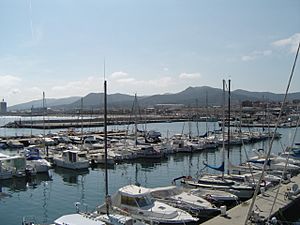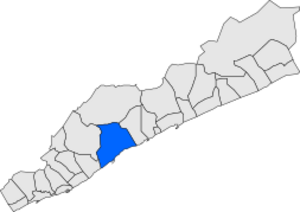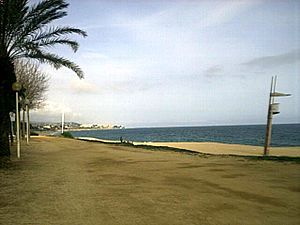Mataró facts for kids
Quick facts for kids
Mataró
|
|||
|---|---|---|---|
|
Municipality
|
|||

Port of Mataró
|
|||
|
|||

Location in Maresme county
|
|||
| Sovereign state | |||
| Community | |||
| Region | Barcelona | ||
| County | Maresme | ||
| Province | Barcelona | ||
| Area | |||
| • Total | 22.5 km2 (8.7 sq mi) | ||
| Elevation | 28 m (92 ft) | ||
| Population
(2018)
|
|||
| • Total | 126,988 | ||
| • Density | 5,644/km2 (14,620/sq mi) | ||
| Demonym(s) | Mataroní | ||
Mataró is a lively city located in Catalonia, Spain. It is the main town and capital of the Maresme area. You can find it on the beautiful Costa del Maresme, just south of the famous Costa Brava. Mataró is about 30 kilometers (19 miles) northeast of Barcelona. In 2021, about 129,749 people lived there.
Contents
History of Mataró

Mataró has a very long history, going all the way back to Roman times. Back then, it was a small village called "Iluro" or "Illuro". You can still visit the ruins of a Roman bath house from the first century BC. This bath house is known locally as the Torre Llauder.
The main coastal road, called the N-II highway, follows the exact path of an old Roman road. This ancient road was known as the Via Augusta.
Mataró was officially made a city by a special royal order. This happened even though its population was smaller than what was usually needed for a city at that time.
The First Railway in Spain
Mataró is famous for having the first railway line in peninsular Spain. This line connected Mataró to Barcelona. It opened on October 28, 1848. A local businessman from Mataró, named Miquel Biada, helped make this important project happen.
Today, this old railway line is part of the modern R1 train service. This service runs between L'Hospitalet de Llobregat and Maçanet-Massanes. Mataró is also connected to Barcelona and Girona by the C-32 freeway. Another freeway, the C-60, connects it to Granollers.
Mataró and the Olympics
During the 1992 Summer Olympics held in Barcelona, Mataró played a special role. It was the starting point for the marathon races.
Main Sights to See
Mataró is the hometown of a very famous architect named Josep Puig i Cadafalch. He was a key figure in the noucentista art movement. He designed many important buildings in the city, including the ajuntament (town hall).
Some of his other amazing designs and notable places in Mataró include:
- Casa Coll i Regàs.
- Casa Parera.
- Casa Sisternes.
- El Rengle.
- Hermitage of St. Simon.
- La Beneficiència.
Mataró City Wall
The Mataró City Wall was built a long time ago, between 1569 and 1600. It was designed by a military engineer named Jorge de Setara. People believe this wall followed the path of an even older Roman wall. It was made from small stones held together with lime mortar. The wall had seven big gates and towers to help defend the city. Many parts of this old wall were taken down in the 1800s.
You can also visit the ancient ruins of the Roman villa of Can Llauder near the town.
Agriculture in Mataró
Long ago, Mataró had many vineyards. But in the 1800s, tiny insects called Phylloxera destroyed most of them. Farmers only replanted some of the vineyards. This was because tourism grew, and new ways to water crops (irrigation) were developed.
Farmers started growing other crops instead. Potatoes became very important, especially a type called Royal Kidney. Mataró even got a special status in 1932 for its potatoes, called a Denominació d'Origen. Farmers also grow Trocadero lettuce and peas. Most of these crops are grown to be sent to other countries. Growing cut flowers is not as big here as in other towns in the Maresme area.
Mataró and the Grape
In the world of wine, there's a red grape called mourvèdre. This grape is also known as "mataro" in Spain, the U.S., and Australia. Many people believe that the city of Mataró is where the "mataro" wine grape originally came from.
Climate
Mataró has a climate that is a mix between a humid subtropical climate and a Hot-summer mediterranean climate. This means it usually has warm, wet summers and mild winters.
| Climate data for Mataró (data from 1931 to 1969) | |||||||||||||
|---|---|---|---|---|---|---|---|---|---|---|---|---|---|
| Month | Jan | Feb | Mar | Apr | May | Jun | Jul | Aug | Sep | Oct | Nov | Dec | Year |
| Mean daily maximum °C (°F) | 14.0 (57.2) |
13.7 (56.7) |
15.8 (60.4) |
17.2 (63.0) |
20.3 (68.5) |
24.0 (75.2) |
26.8 (80.2) |
27.3 (81.1) |
25.1 (77.2) |
21.6 (70.9) |
16.9 (62.4) |
13.8 (56.8) |
19.7 (67.5) |
| Daily mean °C (°F) | 10.3 (50.5) |
10.2 (50.4) |
12.3 (54.1) |
14.0 (57.2) |
16.9 (62.4) |
20.7 (69.3) |
23.5 (74.3) |
23.9 (75.0) |
21.7 (71.1) |
18.0 (64.4) |
13.6 (56.5) |
10.6 (51.1) |
16.3 (61.3) |
| Mean daily minimum °C (°F) | 6.7 (44.1) |
6.7 (44.1) |
8.9 (48.0) |
10.7 (51.3) |
13.5 (56.3) |
17.3 (63.1) |
20.2 (68.4) |
20.4 (68.7) |
18.2 (64.8) |
14.5 (58.1) |
10.4 (50.7) |
7.4 (45.3) |
12.9 (55.2) |
| Average precipitation mm (inches) | 33 (1.3) |
53 (2.1) |
50 (2.0) |
45 (1.8) |
66 (2.6) |
42 (1.7) |
27 (1.1) |
33 (1.3) |
56 (2.2) |
91 (3.6) |
74 (2.9) |
35 (1.4) |
605 (24) |
| Source: Sistema de Clasificación Bioclimática Mundial | |||||||||||||
Festivals and Events
Mataró celebrates many exciting events and festivals each year. Some of these are celebrated all over Catalonia. Others have religious roots and are part of the local folklore and traditions. Here are some of the most popular ones:
- The three wise men in Mataró: This celebration welcomes the Three Wise Men.
- Carnival in Mataró: A fun festival with parades and costumes, celebrated just before Lent.
- Easter in Mataró: A week-long celebration that happens in spring, usually between late March and early May.
- Saint George in Mataró: Celebrated on April 23. It's a big celebration, even though it's not a public holiday.
- St. John the Baptist in Mataró: Celebrated on June 24 with bonfires and fireworks.
- Les Santes: This is the city's main local festival. It happens at the end of July and honors Saint Juliana and Saint Semproniana.
- The caga Tió: A unique Catalan Christmas Eve tradition on December 24.
Mataró also hosts several fairs:
- Tres Tombs: A traditional parade with horses and carts.
- Saint Ponç: In May, there's a fair called Mercat de Sant Ponç. Here, you can find handmade products, special herbs, and natural foods like honey, cheese, fruits, flowers, and jam. Saint Ponç is the patron saint of herbalists and beekeepers. This fair has been held for centuries, starting in the 1500s when herbalists brought medicines to sick people in spring. Today, the Sant Ponç fair helps keep these old traditions alive.
Other events include:
- The "Cultural Crossroad" Festival.
- The International Dance Festival "Days of Dance".
Twin towns
Mataró is twinned with these cities around the world:
 Cehegín, Spain
Cehegín, Spain Dürnau, Germany
Dürnau, Germany Gammelshausen, Germany
Gammelshausen, Germany Créteil, France
Créteil, France Corsico, Italy
Corsico, Italy Fort Lauderdale, United States
Fort Lauderdale, United States
Notable people
Mataró has been home to many interesting people, including:
- Adoración Apolo (born 1979), a footballer.
- Miguel Biada (1789-1848), a sea merchant who helped start the first train connection in Spain.
- Peret (1935-2014), a famous musician.
- Josep Puig i Cadafalch (1867-1956), a well-known Catalan Modernista architect.
- Lamine Yamal (born 2007), a footballer.
See also
 In Spanish: Mataró para niños
In Spanish: Mataró para niños






